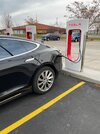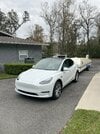Of course, these cars all have access to the CCS stations they use today. And I use CCS stations myself when in certain areas, or I simply use knowledge of their existence to remove any range anxiety in more remote areas -- I know that if I detour and won't make the SC, I can top up at them.
With this network the CCS drivers can have a more reliable and predictable trip along the major highways. The CCS stations, while we tell many nightmare stories about them, do work most of the time. It's just that when you are depending on it, not working even once can screw up a trip. I do feel that Ford drivers, using these stations, and CCS stations with good Plugshare scores, can now have a much more worry-free road trip. Not quite at the level of a Tesla driver with a CCS adapter, which is the best arrangement, but better than before.
It is interesting that they took the step of sending an adapter to every driver. It seems that since there are a LOT more cars than charging stations, a much cheaper and flexible approach would have been to put a locker cabinet at suitable superchargers, which authorized drivers can open to borrow (or even pay a few bucks to rent) an adapter. If you have digital serial numbers in the adapters that the charger can read, you can use that for accounting and also to make them pointless to steal, as they would only work in the stall they were activated for. The lockers would cost some money, but now you can enable any brand of car at no more hardware cost, and even improve the adapters if needed. And put in extension cables in the lockers too. You don't need as many extension cables as you have stalls.




